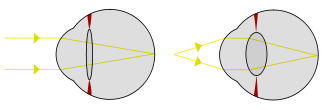accommodation

Light from a single point of a distant object and light from a single point of a near object being brought to a focus by changing the curvature of the lens. Image credit: Wikipedia.
Accommodation is the ability of the eye, or other optical instrument, to change its focus depending on the distance of an object. In humans, and a few other mammals, and in birds and reptiles, accommodation occurs by changing the shape of the lens. At rest, the lens is thin and focused for distant objects. To bring nearby objects into focus, the ciliary muscles contract, causing the lens to become rounder (more convex).
Most mammals cannot accommodate. In fish and amphibians, focusing is achieved, camera-style, by moving the lens backward and forward in relation to the retina.
A young person's ability to accommodate allows him or her to see clearly far away and up close. At about the age of 40, the lens starts to become less flexible and accommodation is gradually lost, making close-range work increasingly difficult. This condition is known as presbyopia.


